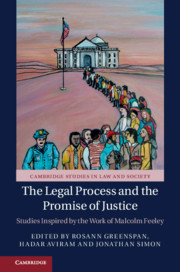Book contents
- The Legal Process and the Promise of Justice
- Cambridge Studies in Law and Society
- The Legal Process and the Promise of Justice
- Copyright page
- Contents
- About the Contributors
- Introduction: Past as Prologue
- Part I The Process Is the Punishment
- Part II Court Reform on Trial
- Part III Judicial Policymaking and the Modern State
- Part IV Political Liberalism and the Legal Complex
- Index
- Books in the Series
- References
Part III - Judicial Policymaking and the Modern State
Published online by Cambridge University Press: 18 April 2019
- The Legal Process and the Promise of Justice
- Cambridge Studies in Law and Society
- The Legal Process and the Promise of Justice
- Copyright page
- Contents
- About the Contributors
- Introduction: Past as Prologue
- Part I The Process Is the Punishment
- Part II Court Reform on Trial
- Part III Judicial Policymaking and the Modern State
- Part IV Political Liberalism and the Legal Complex
- Index
- Books in the Series
- References
Summary

- Type
- Chapter
- Information
- The Legal Process and the Promise of JusticeStudies Inspired by the Work of Malcolm Feeley, pp. 191 - 286Publisher: Cambridge University PressPrint publication year: 2019
References
References
Cases
Burlington Industries v. Ellerth, 524 U.S. 742 (1998).
Costello v. Wainwright, 397 F. Supp. 20, M.D. Fla. (1975).
Faragher v. City of Boca Raton, 524 U.S. 775 (1998).
Furnco Construction v. Waters, 438 U.S. 567 (1978).
Grubb v. W.A. Foote Memorial Hospital, Inc., 741 F.2d 1486 (6th Cir. 1984).
Hudson v. Palmer, 468 U.S. 517 (1984).
Turner v. Safley, 482 U.S. 78 (1987).
Verniero v. Airforce Academy School District No. 20, 705 F2d. 388, (10th Cir. 1983).
Widmar v. Sun Chemical Corp., 772 F.3d 457, 464 (7th Cir. 2014).
Wolff v. McDonnell, 418 U.S. 539 (1974).
References
Bibliography
Cases
Brzonkala v. Virginia Polytechnic Inst. & State University (1997) 132 F.3d 949, USCA 4th Circuit, vote 2–1.
Brzonkala v. Virginia Polytechnic Inst. & State University (1999) 169 F.3d 820, USCA 4th Circuit, en banc vote 7–4.
Civil Rights Cases (1883) 109 US 3; vote 8–1.
Griffin v. Breckenridge (1971) 403 US 88; vote 9–0.
U.S. v. Lopez (1995) 514 US 549; vote 5–4.
U.S. v. Morrison (2000) 529 US 598; vote 5–4.
Amici Curiae Brief of Law Professors in Support of Petitioners, U.S. v. Morrison, 120 S. Ct. 1740 (2000) (Nos. 99–5, 99–29).
U.S. Reply Brief, U.S. v. Morrison (1999).
Legislation
Violence Against Women Act (VAWA), 135 42 U.S.C. § 13981 (1994); (P.L. 103–322)
Violent Crime Control and Law Enforcement Act of 1994, PuB. L. No. 103–322, 108 Stat. 1796. 42 U.S.C.A. § 13981(b)-(c) (1995).
References
Cases
Braggs v. Dunn, United States District Court for the Middle District of Alabama, Civil Action No. 2:14cv601-MHT (WO), June 17, 2017
Brown v. Plata (2011) 563 U.S. 493, 131 S.Ct. 1910
Holt v. Sarver (1969) 300 F.Supp. 825 District Court for the District of Arkansas
Trop v. Dulles (1958) 356 U.S. 86



